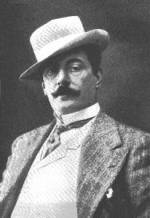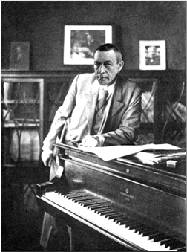Romantic Era: Important Composers, Conductors, and Performers
Franz Liszt (1811-1886)

![]() Listen to the example below:
Listen to the example below:
Hungarian Franz Liszt (1811-1886) began his career as an extraordinary concert pianist. Liszt composed a great deal of music that gave him an opportunity to show off his amazing talent and skill. Having been Hungarian born, he wrote nationalistic music based on Hungarian gypsy melodies. Powerful, expressive, and almost impossible to play by anyone but the most talented pianists, his music is a bold contrast to that of his contemporaries, such as Frédéric Chopin. Liszt was known for his imposing physical presence, his handsome profile leaving an impression on his audience.
Liszt is also credited with the creation of the symphonic poem—an extended single-movement work for orchestra—inspired by art, literature, and theater. The somewhat new concept of program music, or music that was meant to evoke an idea outside of the composition such as a natural landscape, poem, or a particular person, was being explored by composers during this time period. In total, Liszt wrote or arranged over 700 compositions, including 13 symphonic poems, over 90 sacred and secular choral works, and over 150 works for and including the piano.Giacomo Puccini (1858-1924)

Italian composer Giacomo Puccini (1858-1924) was born into a musical family, but as a young child he was said to have been a very poor and undisciplined music student. It wasn’t until he saw an opera that he became inspired to compose. Puccini’s operas are still widely performed today and contain some of the most beautiful opera arias of all time. Puccini’s most famous operas include “La Boheme,” “Madama Butterfly,” and “Turandot.” An aria is an operatic vocal solo, in which the characters usually express their emotions. The example below features the aria “Un bel dia vedremo,” in which the main character, Cio-Cio San (Madama Butterfly), imagines her lover, Lieutenant Pinkerton, returning back to her after a long absence. She sings of her dream of seeing his ship arrive over the horizon and Pinkerton calling her name as he journeys through the city to meet with her at last.
![]() Listen to the example below of the aria “Un bel dia vedremo,” from Madama Butterfly:
Listen to the example below of the aria “Un bel dia vedremo,” from Madama Butterfly:
Puccini’s operas featured stories of everyday life, love, and loss. His heroes and heroines were often regular men and women, singing about their lives and struggles. His moving operas utilized beautiful melodies, interesting orchestration, and dramatic as well as sentimental plot lines. Listen to this example of the duet O soave fanciulla (O Loveliest of Maidens) from the opera La Boheme. A duet is a song for two singers or instruments. This duet features a 1907 performance of the famous tenor Enrico Caruso and Soprano Nellie Melba as the lead characters, the lovers Rodolfo and Mimi.
![]() Listen to the example below of Enrico Caruso and Nellie Melba singing the duet "O soave fanciulla" from Giacomo Puccini's 1896 opera La bohème. It was recorded in New York on 24 March 1907 (3 Minutes 15 seconds):
Listen to the example below of Enrico Caruso and Nellie Melba singing the duet "O soave fanciulla" from Giacomo Puccini's 1896 opera La bohème. It was recorded in New York on 24 March 1907 (3 Minutes 15 seconds):
Attribution: Source The Internet Archive [1] Author Enrico Caruso (1873–1921)), Nellie Melba (1861–1931) Giacomo Puccini (1858-1924)http://commons.wikimedia.org and Adam Cuerden via Wikimedia Commons.
Romantic Era: Composers, Conductors, and Performers, continued
Sergei Rachmaninoff (1873-1943)

![]() Listen to Sergei Rachmaninoff's Piano Concerto No. 3:
Listen to Sergei Rachmaninoff's Piano Concerto No. 3:
Sergei Rachmaninoff (1873-1943) is a Russian pianist and composer who bridged the Romantic and early 20th Century eras. Today, Rachmaninoff is known primarily for his compositions that feature piano and orchestra, including four piano concertos. They are very difficult to perform and are embody the expansive and expressive qualities of the Romantic era. Rachmaninoff’s Piano Concerto No. 3 is one of the most well-known and displays some of his most unique musical ideas.
